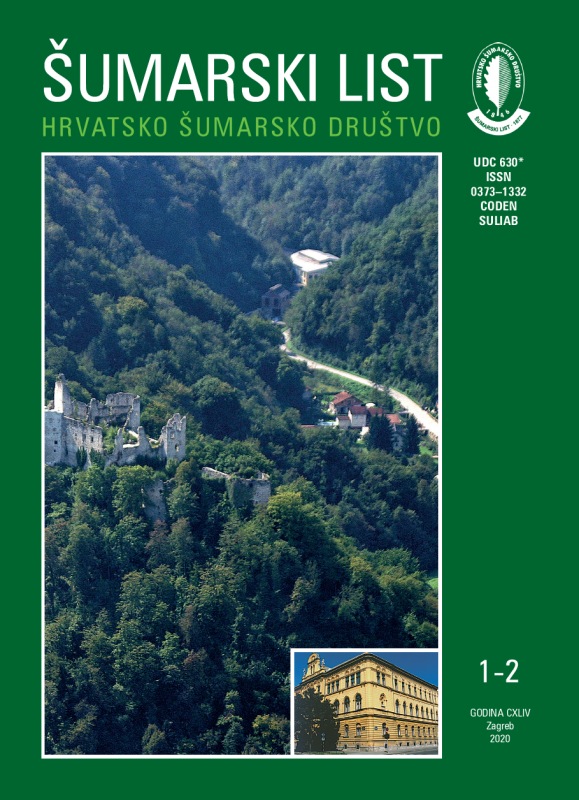
broj: 1-2/2020
pdf (10,44 MB) |
|
||||||||||||||
| RIJEČ UREDNIŠTVA | ||
| Uredništvo | ||
| Should forest pay for everything? pdf HR EN | 5 | |
| IZVORNI ZNANSTVENI ČLANCI | ||
| Tomislav Poršinsky, Vlado Petreković, Andreja Đuka | UDK 630* 523 (001) https://doi.org/10.31298/sl.144.1-2.1 | |
| Bark thickness of wild cherry in timber scaling pdf HR EN | 7 | |
| Stjepan Kvesić, Dalibor Ballian, Mirzeta Memišević Hodžić | UDK 630* 164 (001) https://doi.org/10.31298/sl.144.1-2.2 | |
| Leaf variability of field maple populations (Acer campestre L.) in Bosnia and Herzegovina pdf HR EN | 15 | |
| Osman Mujezinović, Kenan Zahirović, Milivoj Franjević, Mirza Dautbašić | UDK 630* 443 (001) https://doi.org/10.31298/sl.144.1-2.3 | |
| Trophic preferences and influence of beech weevil on the damaged leaf area of beech trees in Bosnia and Herzegovina pdf HR EN | 27 | |
| Sercan Gulci | UDK 630*360 (001) https://doi.org/10.31298/sl.144.1-2.4 | |
| Productivity of a farm tractor with single drum winch during whole-tree timber extraction pdf HR EN | 35 | |
| Vania Kachova, Angel Ferezliev | UDK 630*261 (001) https://doi.org/10.31298/sl.144.1-2.5 | |
| Improved characteristics of Populus sp. ecosystems by agroforestry practices pdf HR EN | 45 | |
| PRETHODNO PRIOPĆENJE | ||
| Natalie Levandovska, Jaromir Kolejka, Božena Šera, Hubert Zarnovičan | UDK 630* 270 + 907 https://doi.org/10.31298/sl.144.1-2.6 | |
| The recreational potential of urban forests – an application of the assessment method pdf HR EN | 53 | |
| STRUČNI ČLANCI | ||
| Zvonimir Ištvan | UDK 630* 902 https://doi.org/10.31298/sl.144.1-2.7 | |
| 145 year of forestry in Podravina pdf HR EN | 65 | |
| Drago Biondić | UDK 630* 762 + 799 https://doi.org/10.31298/sl.144.1-2.8 | |
| Integral performance index of small and medium wood industrial financial products pdf HR EN | 75 | |
| Summary This paper aims to present in a short form a relatively simple methodology of integral performance evaluation and the possibility of its application in small and medium-sized timber industrial enterprises. With some adjustments to the assessment elements, the method is applicable in all industries and services. Integral performance evaluation is in the function of achieving business excellence. The performance appraisal method itself involves benchmarking against the desired state and partly an in-depth analysis of operating results. Integral performance appraisal involves the systematic comparative review of the results achieved by the elements, functions and organization as a whole. In a narrow format, the method, based on the perception of business results in relation to the desired situation, can be applied to self-assessment of the timber industry business with the prior brief management training. A more objective assessment of effectiveness through detailed implementation of the methodology can be achieved through the engagement of an interdisciplinary team of consultants. The management and all employees of the company should be open for cooperation during the consultants’ work in the company. Collaboration with consultants to protect the confidentiality of company data, includes analysis of documentation, recording and reviewing technical and economic data, interviewing employees at all levels, interviews of stakeholders from the environment and calculating all coefficients, shares and rates that can be compared to the desired situation. In addition, in a very abbreviated form, information will be provided on the integral estimates of the performance index by element, function and organization as a whole for an imaginary firm that manufactures solid wood furniture that produces furniture according to customer’s designs. For the sake of brevity, this could not show all the automatically obtained graphs by function, which could clearly show the inefficiency of each element in the management, development of innovative and promotion of new products, in the organization of business and production, digital transformation, growth and development. and finance. In this way, it would be easy to detect in which elements changes in the business should be introduced, most likely with the need to use external expertise. The integral performance evaluation for the nine imaginary manufacturing company features shown in Table 2 and Chart 1. was calculated after the automatic entry of ratings and indices and the previous nine tables that could not be displayed for the limited length of this paper. The average scores so entered in Table 2 are multiplied by the intensity of the impact and an average score of 2.83 is obtained, which gives an imaginary enterprise efficiency index of 56.52%. See table 2 INTEGRAL PERFORMANCE INDEKS and Graph 1. Display of performance index by manufacturing company functions The minimum efficacy with respect to the desired incidence rate should range from 20.00 % to 70.00 %, and the partially satisfactory efficacy ratio with respect to the desired incidence rate should range from 71.00% to 90.00% , satisfactory to the desired state of efficacy with respect to the desired one according to the intensity intensity should range from 91.00% to 100.00% The efficiency of an imaginary manufacturing company in the wood processing industry in 2017 relative to the desired state by function is minimal and ranges from 46.00% to 67.00% with an integral index of 65.52%. Consequently, a thoughtful manufacturing company is the least effective in the areas of management, innovation development and new product promotion, business organization and production, digital transformation, and growth and development, resulting in poor financial efficiency. From all of the above, it can be concluded that with the application of the methodology of integral efficiency index in the small and medium enterprises of wood processing industry, within three to five days, the areas with the scope of necessary changes and improvements in business can be successfully detected, all with the aim of constant approaching excellence and increasing competitiveness. Key words: business excellence; efficiency; integral approach; performance appraisal; interdisciplinary approach; perception; desired state; introduction of changes in business | ||


